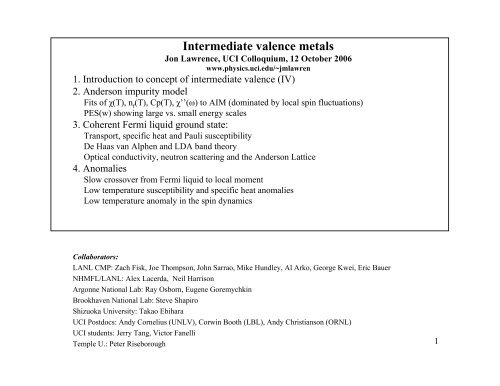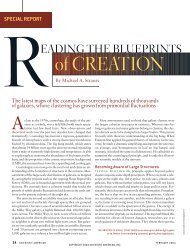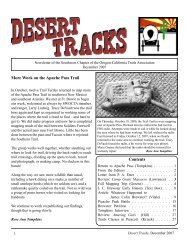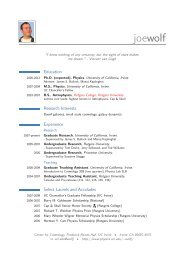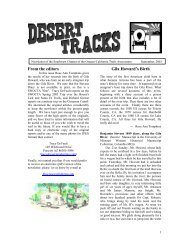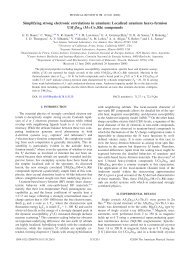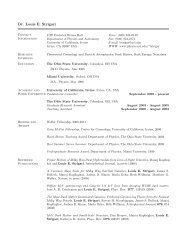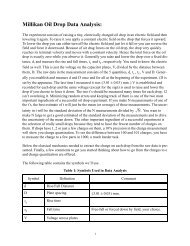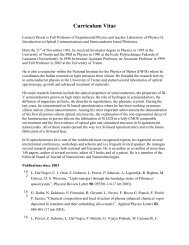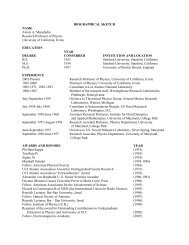Intermediate valence metals
Intermediate valence metals
Intermediate valence metals
Create successful ePaper yourself
Turn your PDF publications into a flip-book with our unique Google optimized e-Paper software.
<strong>Intermediate</strong> <strong>valence</strong> <strong>metals</strong><br />
Jon Lawrence, UCI Colloquium, 12 October 2006<br />
www.physics.uci.edu/~jmlawren<br />
1. Introduction to concept of intermediate <strong>valence</strong> (IV)<br />
2. Anderson impurity model<br />
Fits of χ(T), n f<br />
(T), Cp(T), χ’’(ω) to AIM (dominated by local spin fluctuations)<br />
PES(w) showing large vs. small energy scales<br />
3. Coherent Fermi liquid ground state:<br />
Transport, specific heat and Pauli susceptibility<br />
De Haas van Alphen and LDA band theory<br />
Optical conductivity, neutron scattering and the Anderson Lattice<br />
4. Anomalies<br />
Slow crossover from Fermi liquid to local moment<br />
Low temperature susceptibility and specific heat anomalies<br />
Low temperature anomaly in the spin dynamics<br />
Collaborators:<br />
LANL CMP: Zach Fisk, Joe Thompson, John Sarrao, Mike Hundley, Al Arko, George Kwei, Eric Bauer<br />
NHMFL/LANL: Alex Lacerda, Neil Harrison<br />
Argonne National Lab: Ray Osborn, Eugene Goremychkin<br />
Brookhaven National Lab: Steve Shapiro<br />
Shizuoka University: Takao Ebihara<br />
UCI Postdocs: Andy Cornelius (UNLV), Corwin Booth (LBL), Andy Christianson (ORNL)<br />
UCI students: Jerry Tang, Victor Fanelli<br />
Temple U.: Peter Riseborough<br />
1
<strong>Intermediate</strong> Valence Compounds<br />
CeBe 13 Fermi liquid (FL) YbAgCu 4<br />
CePd 3 FL with anomalies YbAl 3<br />
Ce 3 Bi 4 Pt 3 Kondo Insulator YbB 12<br />
γ-α Ce Valence transition YbInCu 4<br />
<strong>Intermediate</strong> Valence (IV) = Nonintegral <strong>valence</strong><br />
Yb: (5d6s) 3 4f 13 n f<br />
= 1 trivalent<br />
(5d6s) 2 4f 14 n f<br />
= 0 divalent<br />
YbAl 3<br />
(5d6s) 2.75 4f 13.25 n f<br />
= 0.75 IV<br />
Ce: (5d6s) 3 4f 1 n f<br />
= 1 trivalent<br />
(5d6s) 4 4f 0 n f<br />
= 0 tetravalent<br />
CePd 3<br />
(5d6s) 3.2 4f 0.8 n f<br />
= 0.8 IV<br />
Oversimplified single ion model:<br />
Two nearly-degenerate localized configurations form hybridized w.f.:<br />
a[4f 13 (5d6s) 3 > + b [4f 14( 5d6s) 2 > where a = √n f<br />
and b = √(1 – n f<br />
)<br />
2
Basic underlying physics:<br />
Highly localized 4f 13 orbital surrounded<br />
by a sea of conduction electrons<br />
Nearly degenerate with 4f 14 orbital<br />
Energy separation: E f<br />
Strong on-site Coulomb interaction U<br />
between 4f electrons; 4f 12 orbital at<br />
energy E f<br />
+ U where U >> V, E f<br />
Hybridization V between<br />
configurations: conduction electrons<br />
hop on and off the 4f impurity<br />
orbital. Hybridization strength<br />
Γ = V 2 ρ where ρ is the density of<br />
final (conduction) states.<br />
Correlated hopping:<br />
when Γ ~ E f<br />
Key predictions of Anderson Impurity model:<br />
All approximately<br />
Energy lowering due to hybridization:<br />
valid for periodic<br />
k B<br />
T K<br />
~ε F<br />
exp{-E f<br />
/[N J<br />
V 2 ρ(ε F<br />
)]} ~ (1 – n f<br />
) N J<br />
V 2 ρ(ε F<br />
)<br />
IV <strong>metals</strong>.<br />
Kondo Resonance: Narrow 4f resonance at the Fermi level ε F<br />
.<br />
(Virtual charge fluctuations yield low energy spin fluctuations.)<br />
Contributes to the density-of-states (DOS) as ρ f<br />
(εF) ~ 1/T K<br />
.<br />
Mixed <strong>valence</strong> due to hybridization (n f<br />
< 1)<br />
Spin/<strong>valence</strong> fluctuation: localized, damped oscillator with characteristic energy<br />
E 0<br />
= k B<br />
T K<br />
: χ’’~ χ (T) E Γ/((E-E 0<br />
) 2 + Γ 2 )<br />
Universality: Properties scale as T/T K<br />
, E/k B<br />
T K<br />
, μ B<br />
H/k B<br />
T K<br />
High temperature limit: LOCAL MOMENT PARAMAGNET<br />
Integral <strong>valence</strong>: n f<br />
→ 1 z = 2+n f<br />
= 3 Yb 4f 13 (5d6s) 3<br />
Curie Law: χ → C J<br />
/T where C J = N g 2 μ B2 J(J+1)/ 3 k B J = 7/2 (Yb)<br />
Full moment entropy: S → R ln(2J+1)<br />
CROSSOVER at Characteristic temperature T K<br />
Low temperature limit: FERMI LIQUID<br />
Nonintegral <strong>valence</strong> (n f<br />
< 1) Yb 4f 14-nf (5d6s) 2+nf<br />
Pauli paramagnet: χ(0) ~ μ B2 ρ f (ε F )<br />
Linear specific heat: C v ~ γ T γ = (1/3) π 2 ρ f (ε F ) k<br />
2<br />
B<br />
4
Spin fluctuation spectra YbInCu 4<br />
YbInCu 4<br />
Magnetic scattering<br />
S mag vs. E at two incident<br />
energies E i<br />
Lawrence, Osborn et al<br />
PRB 59 (1999) 1134<br />
Lorentzian power spectrum<br />
E<br />
S(E) ~ χ’ E P(E) = χ’ E (Γ/2)/{(E - E 0<br />
) 2 + Γ 2 }<br />
Q-dependence: In YbInCu 4<br />
(Lawrence, Shapiro et al, PRB 55 (1997) 14467) no dependence of Γ or<br />
E 0 on Q and only a weak (15%) dependence of χ’ on Q.<br />
Q-independent, broad Lorentzian response ⇒<br />
Primary excitation is a local, highly damped spin fluctuation (oscillation) at<br />
characteristic energy E 0<br />
= k B<br />
T K<br />
5
0 100 200 300<br />
χ(emu/mol)<br />
0.02<br />
0.01<br />
0.00<br />
T(K) YbAgCu 4<br />
Data<br />
Theory:<br />
W = 0.865<br />
E f<br />
= -0.4485<br />
V = 0.148<br />
T K<br />
(K) = 95K<br />
Fits to the AIM<br />
YbAgCu 4<br />
: Good quantitative fits<br />
to the T dependence of χ, n f<br />
, γ<br />
and to the low T neutron<br />
spectrum<br />
1.0<br />
O data<br />
___ AIM<br />
n f<br />
0.9<br />
S(mb/sr-meV)<br />
0.8<br />
20<br />
10<br />
Two parameters (E f<br />
, V) chosen to fit<br />
χ(0) and n f<br />
(0)<br />
(plus one parameter for background<br />
bandwidth W, chosen to agree with<br />
specific heat of nonmagnetic<br />
analogue LuAgCu 4<br />
)<br />
0<br />
0 5 10 15 20<br />
ΔE(meV)<br />
Lawrence, Cornelius, Booth, et al<br />
6
Comparison to AIM<br />
YbAl 3 : Semiquantitative<br />
agreement<br />
AIM parameters<br />
(Chosen to fit χ(0), n f<br />
(0) and<br />
γ(LuAl 3<br />
))<br />
W = 4.33eV<br />
E f<br />
= -0.58264eV<br />
V = 0.3425eV<br />
T K<br />
= 670K<br />
Cornelius et al<br />
PRL 88 (2002) 117201<br />
The AIM predictions evolve more slowly<br />
with temperature than the data<br />
(slow crossover between the Fermi liquid and the<br />
local moment regime)<br />
and there are low temperature anomalies in the<br />
susceptibility, specific heat and the neutron<br />
spectrum.<br />
7
Comparison to AIM (continued)<br />
YbAl 3<br />
Spin dynamics: Neutron<br />
scattering (Q- averaged)<br />
At T = 100K the neutron scattering<br />
exhibits an inelastic (IE)<br />
Kondo peak:<br />
χ’’(E) = Γ E / ((E- E 1<br />
) 2 + Γ 2 )<br />
representing the strongly damped local<br />
excitation. For YbAl 3<br />
, E 1<br />
/k B<br />
= 550 K<br />
which is of order T K<br />
.<br />
This Lorentzian is still present at 6 K<br />
where experiment gives<br />
E 1<br />
= 50 meV and Γ = 18<br />
meV<br />
while the AIM calculation gives<br />
E 1<br />
= 40meV and Γ = 22meV<br />
(Semiquantitative agreement)<br />
In addition, there is a new peak (low<br />
temperature anomaly) at 32 meV.<br />
Lawrence, Christianson et al, unpublished data<br />
8
The AIM prediction for photoemission<br />
(Gives the relationship between<br />
large and small energy scales)<br />
Primary 4f 1 → 4f 0 emission at<br />
–E f<br />
~ (-2.7 eV in CeBe 13<br />
)<br />
Hybridization width 1 eV = N J<br />
V 2 ρ(ε F<br />
)<br />
{implies exp[-E f<br />
/ (N J<br />
V 2 ρ(ε F<br />
))] = 0.066}<br />
Kondo Resonance near Fermi energy ε F<br />
w/ width proportional to T K<br />
.<br />
5 4 3 2 1 0<br />
Binding Energy (eV)<br />
Lawrence, Arko et al PRB 47 (1993) 15460<br />
Qualitative agreement, but there is a longstanding<br />
argument about the details:<br />
E.g. the relative weight in the KR is larger<br />
than expected, suggesting the 4f electrons<br />
are forming narrow bands near ε F<br />
.<br />
The temperature dependence is also not as<br />
predicted, (perhaps “slow crossover” )<br />
Many problems arise from the high surface<br />
sensitivity of the measurement.<br />
9
TRANSPORT BEHAVIOR OF IV COMPOUNDS<br />
The AIM predicts a finite resistivity<br />
at T = 0 due to unitary scattering<br />
from the 4f impurity.<br />
In an IV compound, where the<br />
4f atoms form a periodic array,<br />
the resistivity must vanish.<br />
(Bloch’s law)<br />
YbAl 3<br />
ρ vs T 2<br />
↓<br />
Typically in IV compounds<br />
ρ ~ A (T/T 0<br />
) 2<br />
This is a sign of Fermi Liquid<br />
“coherence” among the spin<br />
fluctuations.<br />
Ebihara et al<br />
Physica B 281&282 (2000) 754<br />
10
FERMI LIQUID BEHAVIOR<br />
A Fermi liquid is a metal where, despite the strong electron-electron interactions,<br />
the statistics at low T are those of a free (noninteracting) Fermi gas,<br />
but with the replacement m → m* (the effective mass).<br />
The specific heat is linear in temperature C = γ T<br />
γ = {π 2 k B2 N A Z/(3 h 3 π 2 N/V) 2/3 )} m*<br />
For simple <strong>metals</strong> (e.g. K): γ = 2 mJ/mol-K 2<br />
The Fermi liquid also exhibits<br />
m* = 1.25 m Pauli paramagnetism:<br />
e<br />
For YbAl 3 : γ = 45 mJ/mol-K 2<br />
YbAl 3 : χ(0) = 0.005 emu/mol<br />
m* ~ 25 m e<br />
→ “Moderately HEAVY FERMION” compound<br />
C/T vs. T 2 for YbAl 3<br />
γ = 45 mJ/mol-K 2<br />
Ebihara et al<br />
Physica B 281&282<br />
(2000) 754<br />
11
The AIM is qualitatively good (and sometimes quantitatively, e.g. YbAgCu 4<br />
)<br />
for χ (T), C v<br />
(T), n f<br />
(T) and χ’’(ω;T)<br />
essentially because these quantities are dominated by spin fluctuations, which are highly local.<br />
BUT: to get the correct transport behavior and the coherent Fermi Liquid behavior<br />
⇒ Theory must treat the 4f lattice<br />
Two theoretical approaches to the Fermi Liquid State<br />
Band theory: Itinerant 4f electrons: Calculate band structure in the LDA.<br />
One-electron band theory (LDA) treats 4f electrons as itinerant;<br />
it does a good job of treating the 4f-conduction electron hybridization.<br />
It correctly predicts the topology of the Fermi surface.<br />
But: Band theory strongly underestimates the effective masses!<br />
LDA: m* ~ m e<br />
dHvA: m*~ 15-25 m e<br />
And, it can’t calculate the temperature dependence.<br />
Anderson Lattice Model: Localized 4f electrons<br />
Put 4f electrons, with AIM interactions (E f<br />
, V, U), on each site of a periodic lattice.<br />
This loses the details of the Fermi surface<br />
but gets the effective masses and the T-dependence correctly.<br />
Bloch’s law is satisfied for both cases.<br />
12
De Haas van Alphen and the Fermi surface<br />
Figures from Ebihara et al, J Phys Soc Japan 69 (2000) 895<br />
The de Haas van Alphen<br />
experiment measures<br />
oscillations in the<br />
magnetization as a<br />
function of inverse<br />
magnetic field.<br />
The frequency of the oscillations is<br />
determined by the areas S of the<br />
extremal cross sections of the Fermi<br />
surface in the direction<br />
perpendicular to the applied field.<br />
M = A cos(2πF/H)<br />
F = (hc/2 πe) S<br />
The temperature dependence of<br />
the amplitude determines the<br />
effective mass m*<br />
A = 1/sinh(Qm*T/H)<br />
where Q is a constant<br />
13
For IV compounds LDA gives the correct extremal areas!<br />
One-electron band theory (LDA) treats 4f electrons as itinerant.<br />
It correctly predicts the topology of the Fermi surface as observed by dHvA.<br />
But: LDA strongly underestimates the effective masses!<br />
LDA badly overestimates the 4f band widths and consequently strongly underestimates the<br />
effective masses:<br />
LDA: m* ~ m e<br />
dHvA: m*~ 15-25m e<br />
14
Large effective masses in YbAl 3<br />
Ebihara, Cornelius, Lawrence, Uji and Harrison<br />
cond-mat/0209303<br />
The effective masses:<br />
Band 14 electron branch β: 23 me<br />
Band 13 hole branch ε: 17 me<br />
Band 13 electron branch α: 13 me<br />
High field dHvA shows that the effective masses for H//<br />
decrease substantially for H > 40T. This field is much smaller<br />
than the Kondo field B K = kT K /gJμ B required to polarize the f<br />
electrons, but is of order k B T coh /μ B .<br />
A field of this magnitude also<br />
suppresses the low temperature<br />
susceptibility anomaly.<br />
15
ANDERSON LATTICE<br />
Anderson Impurities on a periodic lattice<br />
Level crossing: Narrow 4f band at energy E f<br />
below the Fermi level ε F<br />
hybridizing, with matrix element V, with<br />
wide conduction band whose density of states is ρ.<br />
With no Coulomb correlations (U = 0): hybridization/level repulsion<br />
Band structure with a hybridization gap Δ = N J<br />
V 2 ρ.<br />
With Coulomb correlations (U ≠0): U inhibits free hopping<br />
Coherent band structure has hybridized bands near ε F<br />
but renormalized parameters: V eff<br />
= (1-n f<br />
) 1/2 V and U eff<br />
= 0.<br />
Hybridization gap Δ eff<br />
with indirect gap of order T K<br />
T K<br />
, local moments uncoupled<br />
from band electrons.<br />
16
Optical conductivity<br />
BEST EVIDENCE FOR THE HYBRIDIZATION GAP AND ITS RENORMALIZATION WITH<br />
TEMPERATURE<br />
YbAl 3<br />
High temperature:<br />
Normal Drude behavior from<br />
scattering<br />
from local moments:<br />
σ’(ω) = (ne 2 /m b<br />
){τ / (1 + τ 2 ω 2 )}<br />
m b<br />
: bare band mass, τ is the relaxation<br />
C<br />
R<br />
O<br />
S<br />
S<br />
O<br />
V<br />
E<br />
R<br />
Okamura et al, J Phys Soc Japan 73 (2004) 2045<br />
Low temperature:<br />
IR absorption peak from vertical (Q = 0)<br />
transitions across hybridization gap<br />
Very narrow Drude peak. Both m and τ<br />
renormalized: m b<br />
→ λ m b<br />
= m*<br />
τ→λτ= τ* 17
Neutron Scattering<br />
Both interband (across the gap) and intraband (Drude-like scattering near the<br />
Fermi energy) are expected in the neutron scattering, but in this case excitations at<br />
energy transfer ΔE can have finite momentum, transfer Q.<br />
ε F<br />
(KI)<br />
Q<br />
ΔE<br />
ε F<br />
(IV FL)<br />
E(q)<br />
The intergap excitations, whose intensities are<br />
proportional to the joint (initial and final)<br />
density of states (DOS), should be biggest<br />
for zone boundary Q which connects<br />
regions of large 4f DOS. The energy for<br />
this case is the indirect gap. For smaller<br />
Q, the spectrum should be more like the<br />
optical conductivity (Q = 0), i.e. on the<br />
scale of the direct gap.<br />
q<br />
q BZ<br />
18
15<br />
(a)<br />
(b)<br />
YbAl 3<br />
E i<br />
= 120meV<br />
T = 6K<br />
10<br />
5<br />
Neutron scattering YbAl 3<br />
(Q-resolved)<br />
0<br />
15<br />
(1.07, -0.07, 0)<br />
(c)<br />
(d)<br />
(1.46, 0.04, 1)<br />
The low temperature magnetic scattering<br />
shows two features:<br />
S mag<br />
10<br />
5<br />
1) A broad feature near E 1<br />
= 50 meV, which<br />
energy is essentially k B<br />
T K<br />
. .<br />
This is<br />
most intense for zone boundary Q.<br />
0<br />
15<br />
10<br />
(0.80,0.5,0.5)<br />
(e)<br />
(f)<br />
(0.55,-0.55,0.5)<br />
2) A narrow feature near E 2<br />
= 30 meV, the<br />
energy of the deep minimum in the optical<br />
conductivity. This is independent of Q.<br />
5<br />
(0.80,-0.27,0)<br />
0<br />
(1.15, -0.15, 1)<br />
0 20 40 60 0 20 40 60<br />
ΔE(meV)<br />
Christianson et al, PRL 96 (2006) 117206<br />
19
Neutron scattering YbAl 3 : Q dependence<br />
This plot integrates over the E 1<br />
= 50 meV<br />
intergap excitation at various positions in the<br />
Q K<br />
, Q L<br />
scattering plane. Peak intensity<br />
occurs near<br />
(Q K<br />
,Q L<br />
) = (1/2, 1/2)<br />
i.e. at the zone boundary,<br />
This Q-dependence is as expected for intergap<br />
transitions in the Anderson lattice<br />
Christianson et al, PRL 96 (2006) 117206<br />
This plot integrates over Q at Q L<br />
= 0.<br />
The band of constant color near<br />
E 2<br />
= 32 meV means that the excitation<br />
is independent of Q along the Q K<br />
direction.<br />
Such an excitation does not occur in the<br />
theory of the Anderson lattice. It<br />
corresponds to a localized excitation<br />
in the middle of the hybridization gap<br />
– like a magnetic exciton.<br />
20
Conclusions<br />
Properties of IV compounds such as the susceptibility, specific heat, temperaturedependent<br />
<strong>valence</strong> and Q-integrated neutron scattering line shape, which are<br />
dominated by highly localized spin fluctuations, fit qualitatively and sometimes<br />
quantitatively to the Anderson impurity model.<br />
Properties that are highly sensitive to lattice order – d.c. transport (resistivity), optical<br />
conductivity, de Haas van Alphen – require treatment of the lattice periodicity. Band<br />
theory gets the shape of the Fermi surface correctly, but can’t get the large mass<br />
enhancements or the temperature dependence. Anderson lattice theory gets the mass<br />
enhancements and the temperature dependence but forsakes the Fermi surface<br />
geometry. It predicts key features of the optical conductivity and the neutron<br />
scattering, in particular that there will be a hybridization gap, with intergap transitions<br />
strong for momentum transfer Q at the zone boundary.<br />
However, there are many anomalies: the susceptibility and specific heat are enhanced<br />
at low T relative the models, and evolve more slowly with temperature than expected<br />
based on the AIM. In addition, there appears to be a localized excitation in the<br />
hybridization gap that is also not predicted by the models.<br />
21


